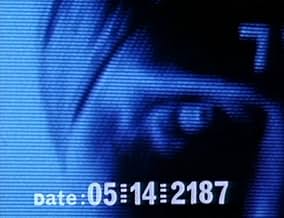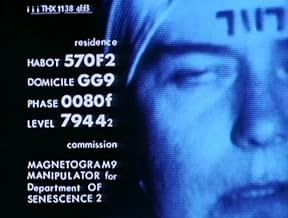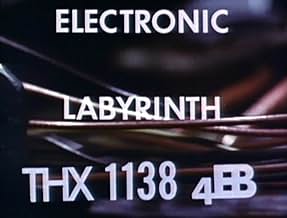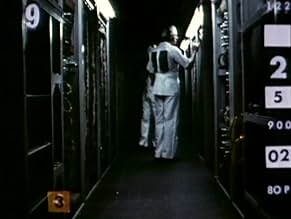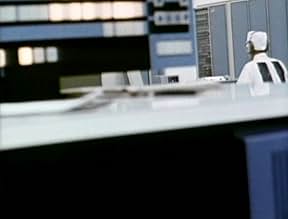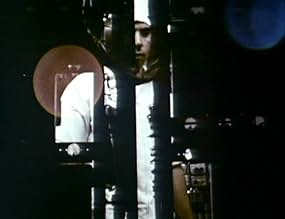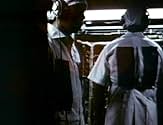Electronic Labyrinth THX 1138 4EB
- 1967
- 15m
IMDb RATING
6.2/10
2.8K
YOUR RATING
While monitored and pursued, a man races to escape through a futuristic labyrinth.While monitored and pursued, a man races to escape through a futuristic labyrinth.While monitored and pursued, a man races to escape through a futuristic labyrinth.
- Awards
- 1 win total
- Director
- Writers
- All cast & crew
- Production, box office & more at IMDbPro
Featured reviews
Having seen the feature length version first, it's hard not to see this short in light of it. The connection between the two is strong and obvious. Both have style over story, and the style is intentionally confusing/busy, dystopian and impressive. In my review of the feature length movie, I especially focused on how well picked the locations were, and the same has to be said (though in an understandably lesser degree) for the short.
I'm more forgiving for a weak story in a short movie like this, as it is in no way in focus. You're only meant to put together what few details you are given, and not expected to become (that) emotionally involved in the world it is set in.
Consdering it is a (cheaply made) student film, Lucas does a remarkable job showing of his visual chops, and using the sci-fi genre to point out negative aspects of his own time.
I'm more forgiving for a weak story in a short movie like this, as it is in no way in focus. You're only meant to put together what few details you are given, and not expected to become (that) emotionally involved in the world it is set in.
Consdering it is a (cheaply made) student film, Lucas does a remarkable job showing of his visual chops, and using the sci-fi genre to point out negative aspects of his own time.
After seeing the theatrical THX 1138 and enjoying its feel very much, I was hyped to be able to see this student project. Let me say that, first and foremost, most of the shots in this film are of absolutely nothing happening. Shots of mainframe computers and other such gadgetry probably lent this film quite an alien feel in 1967, but now it merely fills time waiting for the plot to advance. For 15 minutes, you watch as the story of THX slowly unfolds, how he runs to escape his sterile surroundings and finally reaches his goal.
Probably the most remarkable thing I noticed about this movie is how things changed and how they stayed the same for Lucas in his later pictures. He still treats his actors like action figures. However, I noticed the utter lack of 'cute ideas' that spiced up even the theatrical release of this film. Very monochromatic in emotion and execution, but still gripping in a very real way.
Probably the most remarkable thing I noticed about this movie is how things changed and how they stayed the same for Lucas in his later pictures. He still treats his actors like action figures. However, I noticed the utter lack of 'cute ideas' that spiced up even the theatrical release of this film. Very monochromatic in emotion and execution, but still gripping in a very real way.
While monitored and pursued, a man races to escape through a futuristic labyrinth.
Lucas had had an idea for a long time "based on the concept that we live in the future and that you could make a futuristic film using existing stuff". Fellow USC students Matthew Robbins and Walter Murch had a similar idea which Robbins developed into a short treatment, but Robbins and Murch lost interest in the idea, whereas Lucas was keen to persist.
Because of the USC's Navy connection, Lucas was able to access filming locations which would not otherwise have been available to him: the USC computer center, a parking lot at UCLA, the Los Angeles International Airport, and the Van Nuys Airport. Much of the filming was done at night, with some at weekends.
This film's value is in the fact it is a root. By itself, it is a very good student film, but still just that: a short student film. But we know what came of this. It turned into a feature-length film, it caught the attention of Steven Spielberg, and soon we had "Star Wars" and "Indiana Jones". Without this, we would have none of that, and Harrison Ford would be unemployed.
Lucas had had an idea for a long time "based on the concept that we live in the future and that you could make a futuristic film using existing stuff". Fellow USC students Matthew Robbins and Walter Murch had a similar idea which Robbins developed into a short treatment, but Robbins and Murch lost interest in the idea, whereas Lucas was keen to persist.
Because of the USC's Navy connection, Lucas was able to access filming locations which would not otherwise have been available to him: the USC computer center, a parking lot at UCLA, the Los Angeles International Airport, and the Van Nuys Airport. Much of the filming was done at night, with some at weekends.
This film's value is in the fact it is a root. By itself, it is a very good student film, but still just that: a short student film. But we know what came of this. It turned into a feature-length film, it caught the attention of Steven Spielberg, and soon we had "Star Wars" and "Indiana Jones". Without this, we would have none of that, and Harrison Ford would be unemployed.
Sure it may be no-budget, sure it may be using film equipment and film stock that's not to the 'studio' standard. But, as someone who has come out of being a film student, I look at George Lucas's award-winning student short film with a good deal of awe. And Lucas, who has described himself as being a filmmaker who is split between the avant-garde and the more 'mainstream' films (the latter personified film-wise in Star Wars and Indiana Jones), goes to the extreme of his powers with his visual prowess. It is surreal in that it tries to express an idea through an unconventional means, with a story but without being stuck to it by any means. And because it's so short there's only so much time to get the message across with such little film.
Electronic Labyrinth takes just a slice- the more action packed and suspenseful slice- from what would become the feature film of THX 1138, using absolutely no dialog. That to me is a phenomenal, but very dangerous, step to take. There's always the chance, especially with young, experimental filmmakers, to go into the over-indulgent, or rather just to go in over your head with abstract concepts that just don't connect out of likely just not being well made. Here the quasi-beating over-the-head of image and sound works, because it's a film about technology, about the control of it over people, and it makes a very basic kind of statement of going against the overwhelming power of it. The hero of the film for almost all of the film does a lot of running, down corridors, down spacious, domineering spaces, leading up to a sort of bleak ending.
It may not get enough thematic ground like the feature-version does, and the lack of dialog sets a kind of gap between a viewer not ready for the combination of twistingly sci-fi visuals of the screens and numbers and videos and such. But it's got guts, and that's what I like to see in student films; the cliché that this is a "sign of things to come" is not far from the truth (ironically, after the feature-film of this, it would go more towards the mainstream for Lucas, but you never know).
Electronic Labyrinth takes just a slice- the more action packed and suspenseful slice- from what would become the feature film of THX 1138, using absolutely no dialog. That to me is a phenomenal, but very dangerous, step to take. There's always the chance, especially with young, experimental filmmakers, to go into the over-indulgent, or rather just to go in over your head with abstract concepts that just don't connect out of likely just not being well made. Here the quasi-beating over-the-head of image and sound works, because it's a film about technology, about the control of it over people, and it makes a very basic kind of statement of going against the overwhelming power of it. The hero of the film for almost all of the film does a lot of running, down corridors, down spacious, domineering spaces, leading up to a sort of bleak ending.
It may not get enough thematic ground like the feature-version does, and the lack of dialog sets a kind of gap between a viewer not ready for the combination of twistingly sci-fi visuals of the screens and numbers and videos and such. But it's got guts, and that's what I like to see in student films; the cliché that this is a "sign of things to come" is not far from the truth (ironically, after the feature-film of this, it would go more towards the mainstream for Lucas, but you never know).
Although very little happens in terms of action in George Lucas's best-remembered student film "Electronic Labyringth THX 1138 4EB", there is already plenty to be admired in the visual look alone, considering the assumed small budget they had to work with at the USC. As in all of Lucas's early shorts, the film is very well-made with lots of good craft on display: the locations and costumes, while not overly elaborate, give enough of an atmosphere to suggest an otherworldly environment. The editing is skillful as well, being an almost abstract mishmash of shots and snippets of audio which add to the intensity of the action a little, although it certainly doesn't possess the type of intensity Hollywood would make use of. That aside, the plot itself is rather skimpy and carries plenty of repetition in the images and soundtrack; to expect a greater narrative would be admittedly absurd for fifteen minutes, yet the fact that Lucas took even that long to convey what plot he had shifts the focus to the atmosphere and setting built into it, rather than specifically the plot.
The context of the story is rather unclear, although it is made more interesting simply because we are left to decipher what is happening. The film seems to be occurring in a Dystopian setting as the likes of George Orwell would come up with - a time when the higher powers have taken over, enslaving and ruling over those below them with an iron fist. In this version, the setting is an Electronic Labyrinth in a presumed future when technology has taken over to control the lives of others. The film follows a man, given the designated number 1138, as he attempts to do the unspeakable - escape the slavery of technology, running through shiny white hallways to make it out before he is destroyed by his oppressors. With consistent intercoms blaring instructions on how to stop him mixed with security cam footage and scenes of men in headsets pulling switches, the film's atmosphere is a unique one, repetitive yet oddly surreal, with enough creativity to the settings and costumes to make give it a futuristic feel. The unanswered questions are many, yet they add to the experience - so much so that I doubt I would benefit much if at all from seeing Lucas's 1971 feature film "THX 1138" which elaborates on things. Little plot definitely, yet enough to play with the viewer's mind while simultaneously giving clues through a well-built environment. Certainly remarkable for a student's work, technically and analytically speaking.
The context of the story is rather unclear, although it is made more interesting simply because we are left to decipher what is happening. The film seems to be occurring in a Dystopian setting as the likes of George Orwell would come up with - a time when the higher powers have taken over, enslaving and ruling over those below them with an iron fist. In this version, the setting is an Electronic Labyrinth in a presumed future when technology has taken over to control the lives of others. The film follows a man, given the designated number 1138, as he attempts to do the unspeakable - escape the slavery of technology, running through shiny white hallways to make it out before he is destroyed by his oppressors. With consistent intercoms blaring instructions on how to stop him mixed with security cam footage and scenes of men in headsets pulling switches, the film's atmosphere is a unique one, repetitive yet oddly surreal, with enough creativity to the settings and costumes to make give it a futuristic feel. The unanswered questions are many, yet they add to the experience - so much so that I doubt I would benefit much if at all from seeing Lucas's 1971 feature film "THX 1138" which elaborates on things. Little plot definitely, yet enough to play with the viewer's mind while simultaneously giving clues through a well-built environment. Certainly remarkable for a student's work, technically and analytically speaking.
Did you know
- TriviaThe "EB" referred to in the title means "earth born" according to the original script writer.
- GoofsDuring the credits where George Lucas is mentioned as the director, a piece of transparent tape is visible on the left side of the screen.
- ConnectionsFeatured in Omnibus: George Lucas - Flying Solo (1997)
Details
Contribute to this page
Suggest an edit or add missing content

Top Gap
By what name was Electronic Labyrinth THX 1138 4EB (1967) officially released in India in English?
Answer
